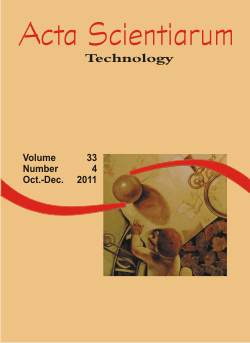Cellulases production by <em>Aspergillus niger</em> and cellulase deactivation kinetic
DOI:
https://doi.org/10.4025/actascitechnol.v33i4.10204Keywords:
Fermentation, enzymes, sugarcane bagasse, enzymatic hydrolysis, lignocelluloseAbstract
This work aimed to evaluate the kinetic for the cellulase production by Aspergillus niger and the deactivation kinetic of the cellulase enzymes. Cellulase were produced in three different batches using NaOH 4% (w v-1) pre-treated sugarcane bagasse as the carbon source in the fermentation broth. The amount of the bagasse in each batch was 10, 50 and 100 g L-1. The kinetic of the cellulase production was accomplished by periodically determining the cellulasic activity of the fermentation broth using pre-treated bagasse as the hydrolysis substrate. Changes in the pH also were determined. The cellulase deactivation kinetic was accomplished by periodically determining the cellulasic activity of the fermentation broth samples stored at 4°C and at -18ºC. One may conclude that Aspergillus niger produces cellulases when grown on medium with pretreated sugarcane bagasse as carbon source. The ideal time to collect the enzymatic broth was about seven days with maximum yield of 0.0013 U mL-1∙h for the batch with 10 g L-1, and 0.0018 U mL-1∙h for the batches with 50 and 100 g L-1. The cellulase complex does not suffer considerable deactivation when stored at -18°C (freezer) for 43 days, however, the activity drops by 40% within 48 hours when stored at 4°C (fridge).Downloads
Download data is not yet available.
Downloads
Published
2011-04-14
How to Cite
Aguiar, C. M., & Lucena, S. L. (2011). Cellulases production by <em>Aspergillus niger</em> and cellulase deactivation kinetic. Acta Scientiarum. Technology, 33(4), 385–391. https://doi.org/10.4025/actascitechnol.v33i4.10204
Issue
Section
Biotechnology
License
DECLARATION OF ORIGINALITY AND COPYRIGHTS
I Declare that current article is original and has not been submitted for publication, in part or in whole, to any other national or international journal.
The copyrights belong exclusively to the authors. Published content is licensed under Creative Commons Attribution 4.0 (CC BY 4.0) guidelines, which allows sharing (copy and distribution of the material in any medium or format) and adaptation (remix, transform, and build upon the material) for any purpose, even commercially, under the terms of attribution.
Read this link for further information on how to use CC BY 4.0 properly.











8.png)




